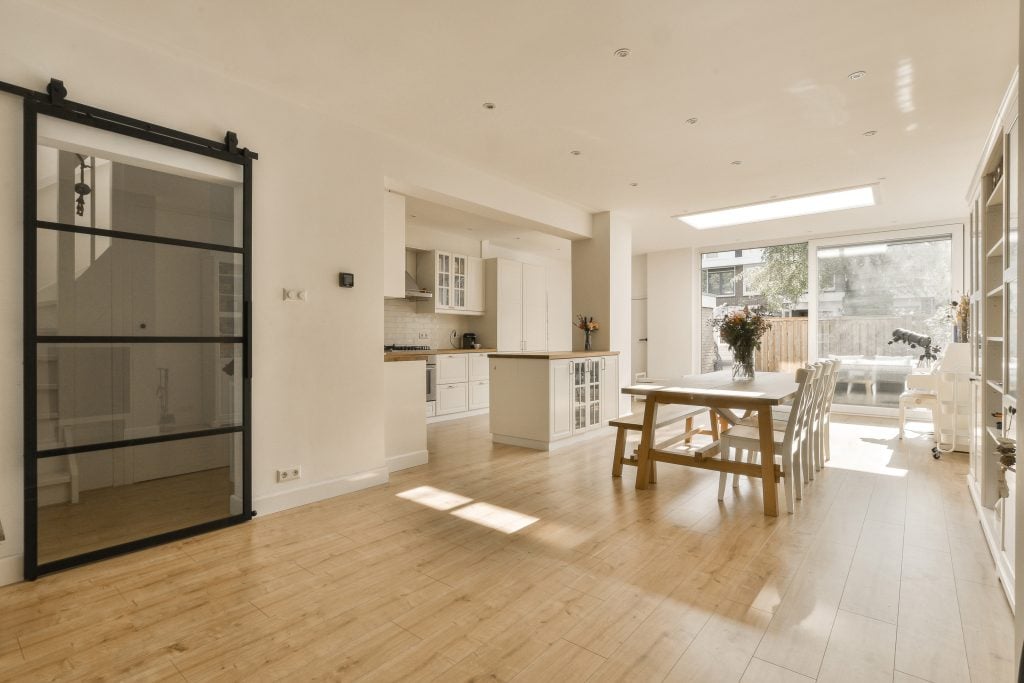

Home extensions are one of the best ways to maximise your living space, especially in North London. Considering the right home extension layout is crucial to making the most of your available space.
Whether you need extra storage, a new bedroom, or a larger kitchen-diner, extensions can dramatically enhance both functionality and aesthetics.
However, creating the perfect extension layout isn’t just about adding square footage. It requires careful planning to meet your needs while staying compliant with local planning permissions and UK building regulations.
In North London, where properties are diverse—from Victorian terraces to Edwardian homes—designing an extension requires insight into your home’s unique character.
It also demands expertise to navigate regulatory requirements. Ignoring these details can lead to costly mistakes or legal challenges.
This is why consulting a professional architect registered with the Architects Registration Board (ARB), such as Gordon Evans and his team at Yoop Architects, is invaluable.
With their experience in North London’s property market and home improvement landscape, they can help you execute your project seamlessly.
A well-planned extension layout can transform your home. Imagine an open-plan living area filled with natural light, a functional home office tucked away, or even a broken-plan design for more privacy.
As we step into 2025, it’s vital to understand the latest trends and ideas for creating layouts that blend practicality with style.
With expert guidance, you can turn your vision into a reality.
Let’s explore innovative ideas, practical tips, and insights to help you design the best home extension layout for 2025.
Top Home Extension Trends UK Homeowners Should Know in 2025
Home extensions layout are evolving beyond traditional concepts, offering innovative solutions that balance style, functionality, and future-focused living.
For UK homeowners, especially in areas like North London where space is at a premium, these trends address common challenges such as limited living areas, outdated layouts, or the need to future-proof homes for growing families.
Thoughtful design trends can significantly enhance both your lifestyle and property value while overcoming these hurdles.
1. Multi-Generational Living Spaces
Families are increasingly struggling to accommodate different generations under one roof, whether it’s ageing parents, adult children returning home, or live-in carers.
Multi-generational layouts offer solutions to preserve harmony while ensuring privacy and independence.
- Private Entrances: Help reduce tension by giving family members their own access points.
- Separate Bathrooms: Eliminate morning rush-hour conflicts in shared spaces.
- Adaptable Rooms: Provide flexible spaces that can evolve as family needs change, from guest rooms to home offices.
By creating spaces tailored to diverse needs, this trend ensures that everyone feels comfortable and valued.
2. Wellness-Focused Extensions
In today’s fast-paced world, many struggle to find time or space to focus on their well-being. Wellness-focused extensions provide a dedicated sanctuary for relaxation, fitness, or mindfulness right at home.
- Home Gyms or Yoga Studios: Save time and money on gym memberships while offering a convenient way to stay active.
- Spa-Like Bathrooms: Provide a retreat from stress with soothing features like rainfall showers, freestanding tubs, and calming finishes.
- Meditation Zones: Offer a quiet, distraction-free environment to recharge mentally.
This trend helps homeowners reclaim their well-being without ever leaving their property.
3. Garden Room Integration
For those feeling disconnected from nature or stuck in homes with dark, enclosed spaces, garden room integration offers a transformative solution.
It creates a seamless indoor-outdoor connection that enhances both mental health and living space functionality.
- Sliding or Bi-Fold Glass Doors: Flood interiors with natural light, improving mood and making small spaces feel larger.
- Covered Outdoor Living Spaces: Provide year-round areas for relaxation, entertaining, or dining.
- Indoor Greenery: Incorporate plants to improve air quality and create a more serene atmosphere.
This approach ensures your home becomes a welcoming, light-filled haven, even in urban areas.
4. Clever Vertical Extensions
For homeowners who feel constrained by limited garden or ground space, vertical extensions provide a creative way to expand. This trend maximises the potential of your property without sacrificing outdoor areas.
- Loft Conversions: Solve the problem of insufficient bedrooms or workspaces without the need for large-scale renovations.
- Mezzanine Floors: Add functional areas in homes with high ceilings, perfect for offices or reading nooks.
- Dormer Windows: Bring in more natural light, making newly added spaces feel airy and welcoming.
This trend is particularly valuable for North London properties, where outdoor space is often at a premium.
5. Heritage-Inspired Extensions
Homeowners with period properties often face the challenge of modernising their homes without losing their character. Heritage-inspired extensions solve this by blending traditional aesthetics with modern functionality.
- Matching Materials: Ensure the extension looks cohesive with the original structure, avoiding a “tacked-on” appearance.
- Traditional Detailing: Add features like sash windows or cornices that respect the home’s history.
- Modern Upgrades: Discreetly include features like underfloor heating, energy-efficient glazing, or smart lighting systems.
This approach preserves the charm of older homes while making them more comfortable and energy-efficient for today’s living standards.
How to Maximise Space in Your Home Extension Layout
Designing a home extension is an exciting journey, but space optimisation can be a challenge, particularly in smaller UK homes.
In North London, where space is often at a premium, making the most of every square metre is vital.
Small homes often come with pain points like limited storage, awkward layouts, or a lack of clearly defined zones. With clever design solutions and expert advice, you can create a space that truly works for your lifestyle.
Smart Ways to Maximise Space in Your Home Extension
- Integrated Storage Solutions
Incorporate built-in cupboards, under-stair storage, or shelving in unused areas to minimise clutter and free up floor space.
- Multi-Purpose Rooms
Design spaces that serve multiple functions, such as a guest room that doubles as a home office or a playroom.
- Zoning Techniques
Use furniture, rugs, or sliding doors to create distinct areas within an open-plan layout, enhancing functionality and flow.
- Vertical Space Usage
Make use of tall walls for shelving or storage units, particularly in loft conversions or spaces with high ceilings.
- Compact Furniture
Choose foldable, stackable, or extendable furniture to maximise flexibility without sacrificing comfort or style.
Open-Plan vs. Broken-Plan: Which Extension Layout Is Best for You?
Choosing between open-plan and broken-plan layouts for your home extension is no small decision.
In the ever-evolving landscape of home design, particularly in the UK, both styles have distinct advantages depending on the function of the space and the type of property.
As space in North London becomes increasingly scarce, homeowners must be strategic about maximising every inch while creating an environment that suits both their lifestyle and aesthetic preferences.
- Open-Plan Extensions: A Modern Choice for Connectivity and Light
Open-plan layouts are particularly popular for contemporary homes, offering a seamless flow between kitchen, dining, and living areas.
This design fosters a sense of spaciousness, making it ideal for homes where social interaction and connectivity are key priorities. However, this style also presents challenges, particularly when it comes to maintaining privacy and acoustics.
Noise can travel easily, and it’s often difficult to create functional zones without defined walls or partitions.
In areas like North London, where larger homes may already have multi-use spaces, the open-plan approach can enhance the sense of freedom but may feel overwhelming in more compact properties.
Pros of Open-Plan
- Enhanced sense of space: Ideal for new builds and modern extensions, it removes barriers and maximises light.
- Ideal for socialising: Promotes family interaction, making it perfect for busy households.
- Aesthetic flow: Works well with minimalist design trends, such as Scandi-inspired interiors.
- More natural light: Fewer walls allow for better light penetration, especially when combined with large glass doors.
Cons of Open-Plan
- Lack of privacy: Difficult to create separate zones for different activities, which can lead to noise disturbances.
- Increased clutter visibility: Everything is in view, and it’s harder to hide the chaos of family life or workspaces.
- Less intimacy: Not ideal for creating quiet, personal spaces.
Broken-Plan Extensions: A Balanced Approach to Structure and Openness
Broken-plan layouts provide a clever balance between the openness of an open-plan space and the privacy and definition of separate rooms.
This type of design has gained traction as it offers versatility for homeowners who want the feeling of openness without compromising privacy or functionality.
Often, broken-plan layouts incorporate partial walls, sliding doors, or even different floor levels to divide spaces while keeping a fluid, interconnected vibe.
In homes with more traditional layouts, such as period properties in North London, broken-plan can offer the flexibility needed to respect the property’s original charm while introducing a modern twist.
In fact, broken-plan is often the best choice for homes where the layout is already segmented or where large open spaces would look out of place.
Pros of Broken-Plan
- Zoning made easy: Offers the benefits of openness but maintains a clear distinction between areas, such as a living zone and a cooking zone.
- Enhanced privacy: You can create more intimate spaces, which is crucial for larger families or multi-generational homes.
- Flexibility: Allows for different functions within the same space without the need for extensive construction work or walls.
- Integration with period properties: More suitable for older homes in North London where traditional layouts are a significant part of the charm.
Cons of Broken-Plan
- Potential for less light: While still an open space, the partial divisions may limit natural light in some areas.
- Complexity in design: Requires careful planning to ensure that the transitions between zones are cohesive and visually pleasing.
- Limited open feeling: For homeowners seeking a completely fluid space, this may not fully satisfy the desire for openness.
How to Incorporate Natural Light and Privacy into Your Home Extension Layout
Both open-plan and broken-plan layouts can benefit from intelligent design choices that maximise light and privacy.
By combining architectural features and design techniques, you can create a space that meets your needs without sacrificing style or function.
Maximise Natural Light
- Use large glass bi-fold or sliding doors to blur the line between indoor and outdoor spaces, flooding your home with natural light.
- Consider installing roof lights or Velux windows to bring in light from above, especially in broken-plan layouts with partial divisions.
- Light colours such as whites, light greys, or soft pastels can help reflect light and make the most of the natural daylight available.
Ensure Privacy
- Use strategic zoning with furniture, such as placing shelves or low partitions to subtly separate areas in an open-plan space.
- In broken-plan extensions, partial walls, half-height dividers, or even glass partitions can separate the kitchen from the lounge area without creating full barriers.
- For bedrooms or quiet zones, retractable doors or curtains offer privacy without compromising the open, airy feel.
Which Layout Is Best for Your Home?
Ultimately, the choice between open-plan and broken-plan comes down to your priorities. Open-plan is ideal for modern families in homes where connectivity and flow are paramount.
However, if your property is a period home or you need privacy alongside an open feel, a broken-plan design may offer a more flexible, balanced solution.
Planning Permission and Design Tips for Home Extension Layout
When considering a home extension in the UK, understanding planning permission rules is crucial.
Navigating through the regulatory landscape can feel overwhelming, but it’s vital to ensure that your extension project complies with local planning regulations and building codes.
Whether you’re extending in North London or beyond, the rules may vary based on property type, location, and the extent of the work.
In general, most home extensions in the UK fall under Permitted Development (PD) rights, meaning that planning permission is not required.
However, there are restrictions to keep in mind, particularly in conservation areas, listed buildings, or if you are extending more than 3 metres from the rear of a semi-detached property.
Planning Permission Guidelines
- Permitted Development (PD) rights: Extensions up to 6 metres for terraced houses or 8 metres for semi-detached homes.
- Designated Areas: Areas like conservation zones, green belts, and AONBs may have stricter rules.
- Height restrictions: Extensions must not exceed 4 metres in height for single-storey structures.
- Building regulations: Ensure compliance with structural, insulation, and safety requirements.
Expert Design Tips to Maximise Space and Style
Maximising your extension layout while staying within these constraints can be challenging, but it’s achievable with expert design advice.
Here are some tips to make the most of your home extension:
- Smart use of space: Focus on multi-functional areas, such as open shelving and fold-away furniture, to save space while maintaining style.
- Natural light: Incorporate large windows or bi-fold doors to enhance the feeling of space and light.
- Maximise ceiling height: Vaulted or raised ceilings add a sense of openness, perfect for creating a light, airy environment.
- Open-plan design: Remove unnecessary partitions for a modern, spacious layout, ensuring the flow of movement is uninterrupted.
Avoid common mistakes such as neglecting storage or overcrowding the space with furniture. A good extension should blend seamlessly with the existing structure while improving function and aesthetics.
How to Work with an Architect to Create the Perfect Extension Layout
An architect plays a pivotal role in creating a functional, aesthetically pleasing home extension layout. They are experts in optimising space, ensuring compliance with regulations, and making your vision a reality.
Working with an architect ensures that you avoid costly mistakes and streamline the process, whether you’re working on a large extension or a more compact design.
Key Roles of Architects
- Space optimisation: Architects can identify opportunities for maximising your space and ensuring it works for your family’s needs.
- Navigating planning permissions: They will help you understand and navigate the planning application process, ensuring all regulatory requirements are met.
- Design expertise: An architect can present creative and innovative ideas that align with your vision while making the most of your budget.
Choosing the Right Architect
- Specialisation in home extensions: Select an architect with experience in home extensions, especially those similar to your project in the North London area.
- Client-focused approach: Look for an architect who listens and understands your needs, helping you express your ideas clearly.
- Portfolio review: Review their portfolio to ensure their design style matches your aesthetic preferences.
How to Communicate Your Vision and Stay Within Budget for Home Extension in North London:
- Be clear on your needs: List your must-haves and areas where you’re willing to compromise.
- Budget setting: Establish a realistic budget early on and discuss it openly with your architect to ensure the design stays within financial constraints.
- Ongoing communication: Regular updates and feedback ensure the project stays on track and aligns with your expectations.
Conclusion
When planning a home extension, thoughtful design and proper planning permissions are essential for success.
Working closely with an architect ensures that your layout not only maximises space and style but also complies with UK building regulations.
Whether you’re after an open-plan or broken-plan design, the right expertise can guide you through the process with ease.
If you’re ready to create your dream home extension, consult professionals like Yoop Architects to bring your vision to life, staying within budget and regulatory boundaries.
Start planning your extension today – with the right guidance, your ideal home extension is just a step away!

